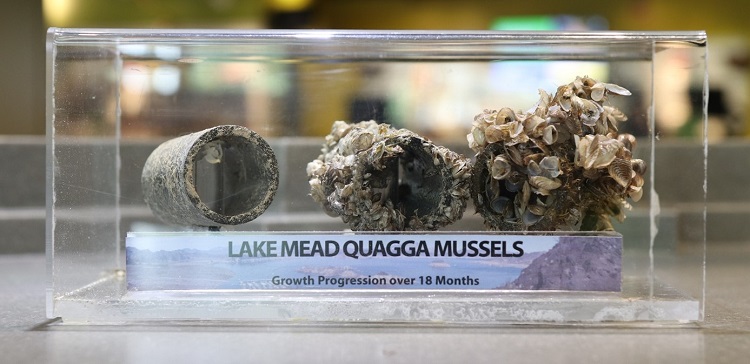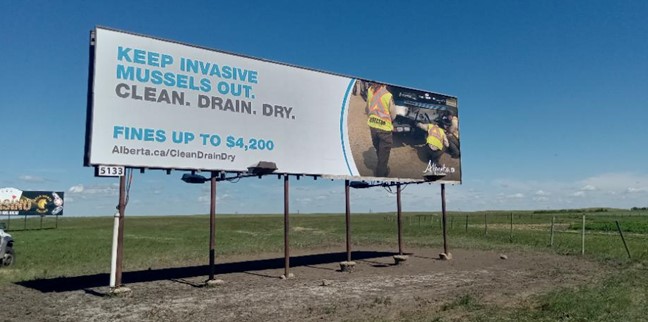Alberta is zebra and quagga mussel free and wants to keep it that way. Reports of invasive species are increasing across Canada and the United States, as tiny mussels can be easily spread through boats and other watercraft. They can rapidly damage waterways and infrastructure, destroy habitats and can cause hundreds of millions in damages.
Alberta is launching a multi-phase campaign to increase awareness of the dangers of invasive mussels and how to keep them out. This long weekend, all boaters are encouraged to avoid big fines and keep the province safe by cleaning, draining and drying their gear and stopping at inspection stations.

A few invasive mussels can rapidly damage boats, ecosystems and infrastructure (Credit: GOA)
"This long weekend, we’re asking for all Albertans’ help in keeping our province invasive mussel free. It’s up to all of us to remain diligent and do our part so these invasive species stay outside our borders. They may be tiny, but the environmental and financial damage they would cause if introduced is massive, so let’s keep ’em out."
Alberta wants to use every tool possible to prevent damage from aquatic invasive species, which can cause huge damage to native fisheries, water quality, irrigation infrastructure and habitats.
This summer, Alberta set the largest fines in North America, raising the fines. Fines for failing to stop with a trailered boat at an open inspection station are now $4,200, and for failing to remove a bilge plug when transporting a watercraft on a roadway are $600. To help educate boaters, Alberta’s government is now launching a multi-phase public awareness campaign.
Billboards are now being displayed near many inspection stations to stop invasive mussels (Credit: GOA)

Billboards are now being displayed near many inspection stations to stop invasive mussels (Credit: GOA)
Billboards highlighting increased fines are now live at key locations across the province, with a social media and online campaign rolling out throughout the summer. We are launching this campaign before the long weekend to ensure all Albertans and visitors going boating this summer are aware of the increased fines, stop at all mandatory watercraft inspection stations, and clean, drain, dry their gear before entering our province.
This campaign will also include retro graphics inspired by the successful Rat Control campaign and will be displayed on posters which will be distributed across the province, social media, digital advertisements, and inspection stations to help reach as many people as possible.
Alberta is stepping up its border defense. Along with the highest fines in North America and public awareness campaign, the government also launched a new Aquatic Invasive Species Task Force and increased the number of inspection stations, added more inspectors, and is keeping stations open as long as possible.
Quick facts:
- As of July 24, Alberta has inspected more than 5,500 boats and other watercrafts, nine of which were confirmed positive for invasive mussels. The boats were all entering Alberta from other provinces in Canada or the United States, including a sailboat travelling from Ontario, a ski boat travelling from Manitoba and a boat coming from Arizona.
- The increased 2024 Aquatic Invasive Species Watercraft Inspections and Decontamination Program:
- Expanded the number of fixed inspection stations to seven and launched a new roving crew.
- Increased the number of dedicated watercraft inspectors to 50, from 35 last year.
- Started opening stations in April, with all stations now open through the September long weekend, and many extending beyond this period.
- Always follow these steps to help prevent the spread of aquatic invasive species and diseases:
- Clean:
- Inspect and clean all watercraft, trailer and gear after every adventure.
- Remove all mud, sand, water and plant traces before leaving the shoreline.
- Rinse, scrub or pressure wash your boat, kayak or canoe and gear on dry land away from storm water drains, ditches or waterways. Do not use a local carwash – if invasive species are present, you could unknowingly introduce them as the water from the carwash is released into the environment.
- Drain: On land, before leaving the water body, drain all water from
- internal compartments (for example: ballasts, bilges and livewells)
- bait buckets
- coolers
- life jackets and other gear
- Raise and lower outboard engines several times to ensure all water has drained out.
- Drain non-motorized watercraft by inverting or tilting the watercraft, opening compartments and removing seats if necessary.
- Dry
- Dry the watercraft and gear completely between trips and allow the wet areas of your boat to air dry.
- Leave compartments open and sponge out standing water.
- Clean:
Related information
- Watercraft inspections
- Letter from Alberta’s environment minister calling for increased federal action